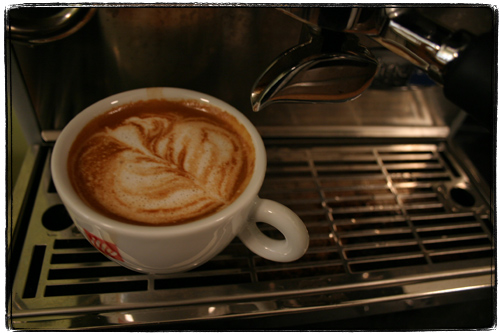often tells me that I should move to Seattle. But there is one reason why I would actually want to move there. And that reason is Espresso Vivace.
You see, this dude Schomer served in the Army as a metrologist. No, not a meteorologist. A metrologist, a person who measures stuff for a living. When he became a civilian again he decided to apply some of his skills to making espresso.
Good espresso is very hard to make. It’s no secret, really. And it’s rather well known what you need to do to make good espresso. To oversimplify things you need:
a) very fresh, properly roasted high quality coffee beans
b) pure water with a certain degree of hardness
c) a good quality burr grinder with very fine grind adjustment
d) a La Marzocco espresso maker with perfectly adjusted for water temperature and pressure
e) a perfectly fitted espresso tamper (such as one made by Reg Barber)
f) a thick walled ceramic cup
and
g) a barrista who knows what he or she is doing.
Now, the barrista must be able to do the following things:
a) correctly adjust the grinder and grind enough beans for one shot. This is a tricky trial and error process – the grinder must be adjusted depending on ambient temperature and humidity.
b) fill the portafilter very evenly with the correct amount of coffee grinds and tamp them down with enough force
d) make sure that the group doesn’t have enough time to cool down
e) place the group into the machine and press the brew button, shutting it off after a correct period of time
f) judge the quality of the resulting espresso shot and throw it out and make a new one if it’s no good
g) keep the machine in immaculate state of cleanliness
All of these steps are important. David Schomer came up with a way to measure and reduce already small temperature fluctuations in La Marzocco machines. He also added extra cooling fans to his grinders to prevent coffee from heating up when ground. He custom made ergonomic perfectly fitted tampers. He measured, modified hardware and technique and then measured again, sharing his secrets with the world.
Right now I am between espresso machines. When my last machine gave up the ghost (word to the wise, don’t buy any consumer grade Nuova Simonelli machines. If they die, you won’t be able to get any service for them) I decided to get nothing other than a used single group La Marzocco. I can’t afford a new one as it costs around 6 grand, but used ones can be had for as little as $1000. One of the problems is of course that it uses 220V electricity, but I’d be willing to pay an electrician to install a 220V outlet for me. Of course some lucky bustard got an experimental 110V machine, but no such luck for me. Besides, I want the real thing. I am horribly tempted to get an ECM Giotto machine that comes recommended by Schomer himself though…
Nah, I don’t want to leave New York just because there no good espresso places here. It’s cheaper just to make my own. Or even one day I might open the real Dead Programmer’s Cafe here. Maybe if I find a partner..
This all kind of reminds me – I am all out of coffee beens. Time to order some more.
